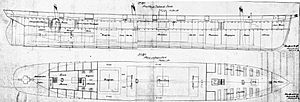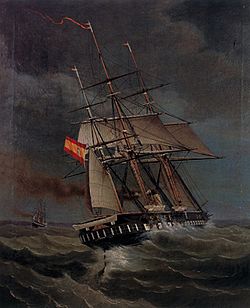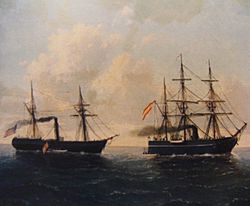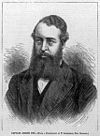Spanish corvette Tornado facts for kids
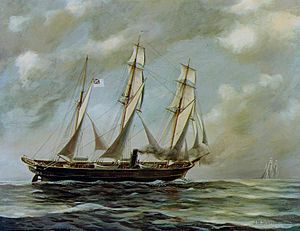
Painting of CSS Alabama, a ship similar to Tornado.
|
|
Quick facts for kids History |
|
|---|---|
| Name | CSS Texas |
| Launched | 1863 |
| Commissioned | 1865 |
| Fate | Purchased by Chile for £75,000. |
| Owner | Chilean Navy |
| Acquired | February 1866 |
| Renamed | Pampero |
| Fate | Captured off Madeira by the Spanish frigate Gerona. |
| Acquired | 1870 |
| Commissioned | 1870 |
| Decommissioned | 1938 |
| Renamed | Tornado |
| Captured | 28 October 1873 |
| Fate |
|
| General characteristics | |
| Displacement | 2,100 tons |
| Length | 231 ft (70 m) |
| Beam | 33 ft (10 m) |
| Propulsion | Steam, sail |
| Speed | 13 knots (24 km/h; 15 mph) |
| Range | 1,700 miles (2,700 km) |
| Armament |
|
The Tornado was a special kind of ship called a corvette. It used both sails and a steam engine to move. It was first built in Scotland in 1863. Its original name was CSS Texas, and it was meant for the Confederate States of America during the American Civil War.
Later, the ship became famous for capturing another ship called the Virginius. This event caused a big problem between Spain and the United States in 1873, known as the "Virginius Affair".
Contents
Building the Tornado
The ship was first planned as a fast cruiser for the Confederate States. It was called CSS Texas. However, the British government took control of it in 1863. In 1865, the Chilean government bought the ship for £75,000.
Designing the Ship
In 1862, a Confederate officer named George T. Sinclair went to England. His job was to have a fast ship built for long voyages. He worked with Commander Bulloch in Liverpool to design the ship. They decided to use the plans for another ship, the CSS Alabama, as a starting point.
The new ship was named Pampero at first. It was built by James and George Thomson in Glasgow. The Pampero was similar to the Alabama but a bit bigger.
Ship Features and Delays
The Pampero was designed to be about 231 feet (70 meters) long and 33 feet (10 meters) wide. It could use both sails and steam power. It had special funnels that could be lowered and a propeller that could be lifted out of the water. This made it good for both sailing and steaming.
The ship's frame was made of iron, and its outer layer was a mix of iron and wood. It was planned to have several powerful guns. The ship was supposed to be ready by July 1863. However, there were many delays.
The United States Consul in Liverpool, Thomas H. Dudley, became suspicious. He heard that a fast steamer was being built for the Confederates. The builders said it was for the Turkish government, but Dudley's spies found out it was for the Confederates.
The ship was finally launched on October 29, 1863. The American consul in Glasgow asked for the ship to be stopped. The British government began legal action against the Pampero in March 1864, but the case was never fully decided.
Capture of the Ship
During the Chincha Islands War, countries in South America looked for warships in Europe. Chile bought two ships in Britain, the Tornado (which was still called Pampero at this point) and the Chilean corvette Abtao.
Setting Sail and Being Chased
The Tornado left Leith, Scotland, on August 19, 1866. It had a British flag and a British crew. It was heading to a neutral place and had no Chilean sailors on board.
The Spanish government had ordered its ships to capture these vessels. The Spanish frigate Gerona sailed from Cádiz and arrived at Madeira, Portugal. There, it saw the Tornado getting ready to leave.
The Gerona began to chase the Tornado. The Tornado tried to stay close to the coast, but the Gerona followed. Even though the Gerona was slower, its captain decided to fire a warning shot. When the Tornado kept going, the Gerona fired three more shots. Finally, the Tornado stopped.
Spanish officers boarded the Tornado to check it. They couldn't tell if it had weapons because it was full of coal. The captain of the Tornado, John MacPherson, was taken to the Gerona. He was rude to the Spanish commander. The Spanish then took control of the Tornado and sailed it to Cadiz. The Tornado's crew of 55 men was moved to the Gerona.
Captain MacPherson and his crew were treated harshly. This caused problems between the British and Spanish governments. Britain said Spain had no right to treat the crew as prisoners of war.
The Tornado in Spanish Service
The ship was brought into the Spanish Navy and officially named Tornado. It was used as a screw corvette.
The Virginius Incident
During the Ten Years' War in Cuba, the Tornado was involved in a famous event. It had an incident with an American ship called the Virginius. The Virginius was being used to secretly bring supplies and people to help rebels in Cuba.
On October 31, 1873, the Virginius was sailing from Kingston, Jamaica to Cuba. It was flying the US flag and carrying war materials. It had 52 crew members (mostly Americans and Britons) and 103 passengers (mostly Cubans). The Tornado spotted the Virginius and chased it. The Tornado captured the Virginius and took it to Santiago de Cuba.
Fifty-three of the crew and passengers were sentenced to death by a military court. Between November 4 and 8, they were executed. Eight American citizens were among them.
This event made relations between Spain and the United States very tense. War seemed possible. However, on December 8, Spain agreed to give the Virginius back to the US. They also agreed to release the surviving crew and passengers. Spain also paid money to the United States and British governments for the executions.
Later Years and Fate
In 1886, the Tornado was changed into a ship for training with torpedoes. From 1898 until 1938, it served as a home for poor children of sailors and fishermen in Barcelona. These children had lost their parents in accidents at sea.
The Tornado was finally sunk by aircraft in 1938 during the Spanish Civil War. Its remains were broken up in 1939.
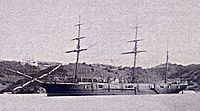
Images for kids
See also
 In Spanish: Tornado (1866) para niños
In Spanish: Tornado (1866) para niños


